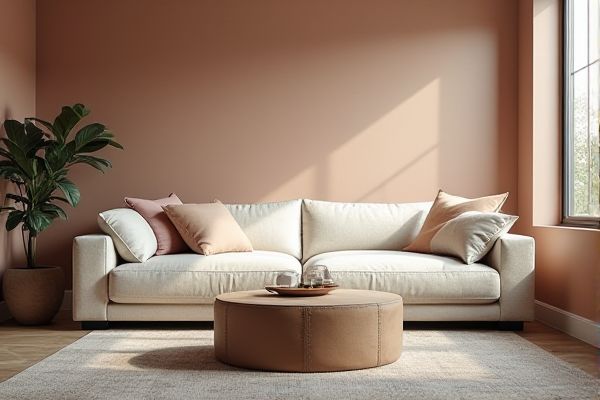
Matte finish offers a non-reflective, smooth surface that minimizes glare and fingerprints, making it ideal for a subtle, sophisticated look, whereas glossy finish provides a shiny, reflective surface that enhances colors and sharpness for a vibrant, eye-catching effect. Discover which finish best suits Your style and needs by reading the rest of the article.
Table of Comparison
| Feature | Matte Finish | Glossy Finish |
|---|---|---|
| Appearance | Non-reflective, smooth, muted tones | Shiny, reflective, vibrant colors |
| Durability | Resistant to fingerprints and smudges | Prone to scratches and visible fingerprints |
| Maintenance | Easy to clean, hides dirt well | Requires frequent cleaning to maintain shine |
| Common Uses | Wall paints, photo prints, camera lenses | Packaging, brochures, smartphone screens |
| Lighting Interaction | Diffuse light, reduces glare | Reflects light, can cause glare |
| Color Perception | Subtle, understated colors | Bright, saturated colors |
Understanding Matte and Glossy Finishes
Matte finishes provide a non-reflective, smooth surface that minimizes glare and fingerprints, making them ideal for reducing distractions and enhancing readability. Glossy finishes offer a shiny, reflective surface that intensifies colors and sharpens details, perfect for vibrant visuals and high-impact presentations. Choosing between matte and glossy depends on your preference for either subtle elegance or vivid clarity in your display or print materials.
Key Differences Between Matte and Glossy
Matte finish surfaces absorb light, resulting in a non-reflective, smooth appearance ideal for reducing glare and hiding fingerprints, while glossy finish reflects light, creating a shiny, vibrant look that enhances color depth and sharpens details. Matte finishes provide a subtle, understated aesthetic suited for minimalistic and modern designs, whereas glossy finishes offer high visual impact, making them popular for photo prints and decorative items. Your choice between matte and glossy depends on whether you prioritize a muted texture that resists smudging or a bright, polished look that highlights colors vividly.
Visual Appeal: Matte vs Glossy
Matte finish offers a smooth, non-reflective surface that reduces glare and provides a subtle, elegant look ideal for minimalist designs and muted tones. Glossy finish delivers vibrant colors with high contrast and sharp details, enhancing visual appeal through its reflective sheen that catches light effectively. Choosing between matte and glossy depends on the desired aesthetic, with matte emphasizing sophistication and gloss highlighting brightness and clarity.
Durability and Maintenance
Matte finishes offer superior resistance to scratches and fingerprints, making them more durable and easier to maintain in high-traffic areas. Glossy finishes, while visually striking with their reflective appearance, tend to show smudges, dust, and scratches more prominently, requiring frequent cleaning. Choosing a matte finish can help preserve the look and longevity of surfaces with minimal upkeep, ensuring your space stays pristine longer.
Fingerprints and Smudge Resistance
Matte finishes provide superior fingerprint and smudge resistance compared to glossy finishes, making them ideal for surfaces frequently touched. Glossy finishes tend to highlight fingerprints and smudges due to their reflective nature, requiring more frequent cleaning to maintain clarity. Choosing a matte finish can help keep Your devices and surfaces looking clean with less effort.
Light Reflection and Glare
Matte finish absorbs light, minimizing reflection and significantly reducing glare, making it ideal for spaces where screen visibility and eye comfort are priorities. Glossy finish reflects light sharply, creating vibrant highlights but often causing unwanted glare that can be distracting or hinder visibility in bright environments. Your choice between matte and glossy should depend on how much light reflection and glare you can tolerate in the intended setting.
Ideal Uses for Matte Finishes
Matte finishes are ideal for surfaces that require low reflectivity and minimal glare, such as wall paint in living rooms, bedrooms, and offices, enhancing a calm and sophisticated ambiance. They are often chosen for high-traffic areas and surfaces prone to fingerprints or smudges, including cabinetry and furniture, due to their ability to conceal imperfections better than glossy finishes. Matte finishes also provide excellent texture for art canvases and photography prints, emphasizing color depth without distracting shine.
Best Applications for Glossy Finishes
Glossy finishes are ideal for applications requiring vibrant color reproduction and high contrast, such as photographs, brochures, and product packaging. Their reflective surface enhances detail and depth, making images appear sharper and more eye-catching. Common uses include magazines, marketing materials, and automotive coatings where visual appeal and durability are paramount.
Cost Comparison: Matte vs Glossy
Matte finishes typically cost more due to the special coatings and production processes required to achieve their non-reflective surface, while glossy finishes are generally less expensive and easier to produce. Your choice between matte and glossy finish impacts overall budget, with glossy options providing a more affordable solution, especially for large-scale projects or bulk printing. Cost differences depend on factors like material type, print size, and supplier pricing, making it essential to get detailed quotes for accurate comparison.
Making the Right Choice for Your Project
Matte finish provides a non-reflective, smooth surface ideal for reducing glare and hiding imperfections, making it perfect for walls in high-traffic areas or artwork with intricate details. Glossy finish offers a shiny, reflective surface that enhances color vibrancy and makes surfaces easier to clean, suitable for kitchens, bathrooms, and furniture accents. Choosing between matte and glossy finishes depends on the desired aesthetic, maintenance needs, and the environment where the project will be located.
 homyna.com
homyna.com